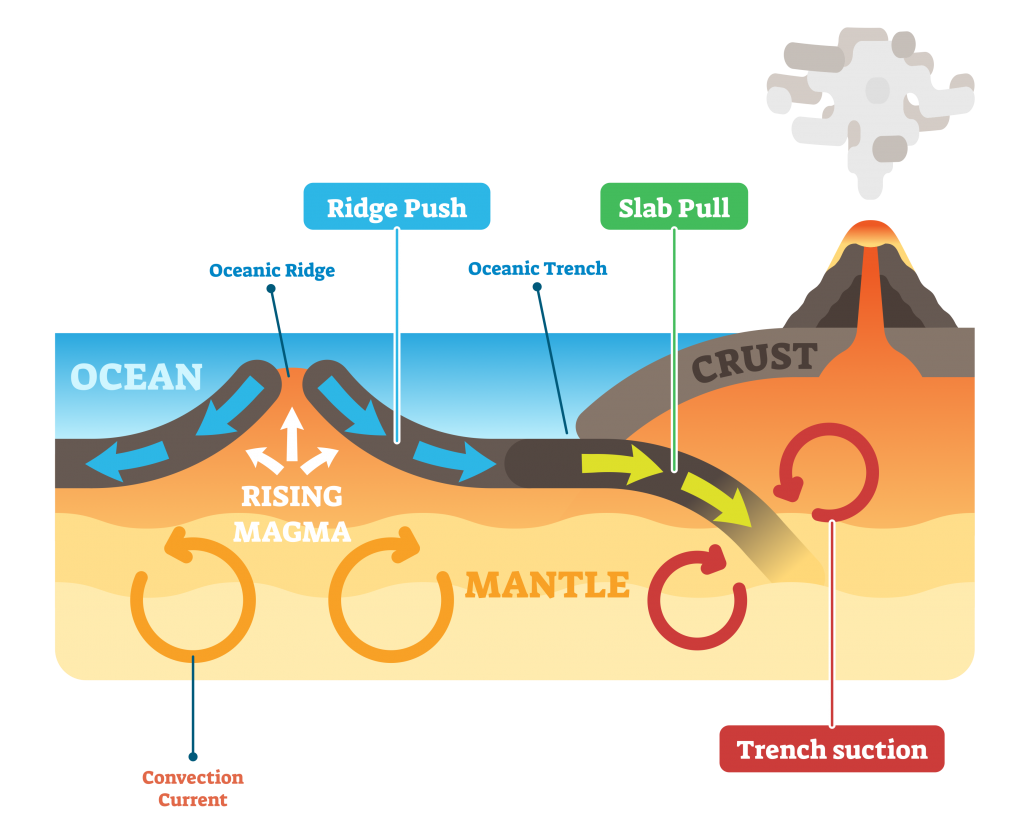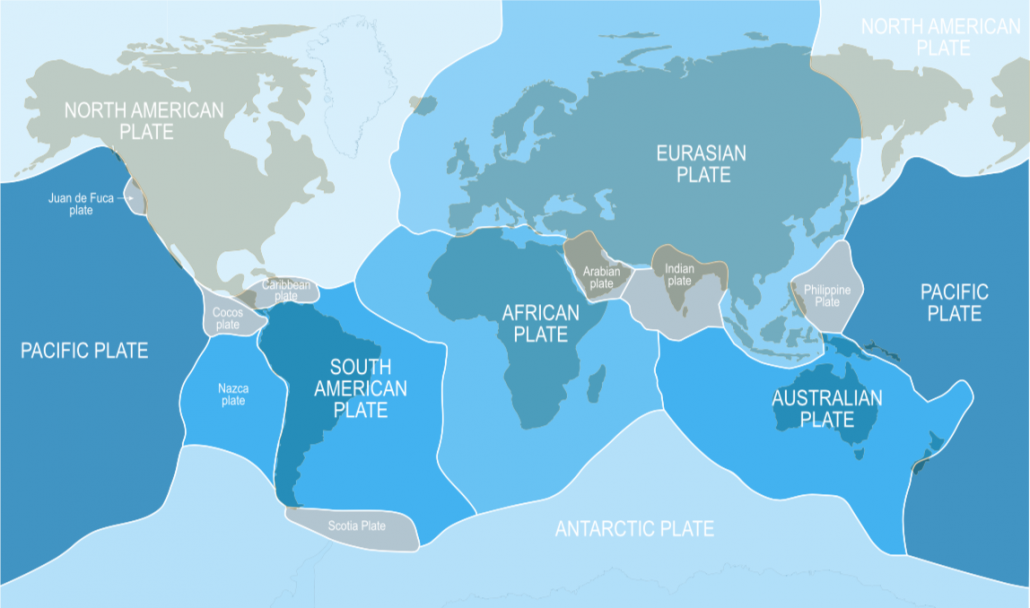Why do volcanoes and earthquakes happen?
To know why volcanoes and earthquakes happen and the reasons for their global distribution, you need first to understand the structure of the Earth and plate tectonics.
What is the structure of the Earth?
The Earth has four main layers, the inner core, outer core, mantle and crust.
The inner core forms the Earth’s centre and is 1400 km across. The inner core is solid and dense; in fact, it is over five times denser than rocks on the surface and is made up of iron (80%) and nickel and has a temperature of around 5500°C.
Surrounding the inner core is the outer core. The outer core is dense, semi-molten metal and is around 2100 km thick. The temperature of the outer core is between 5000 and 5500°C. Outside the core is the mantle. The mantle is a semi-molten layer around 2900 km thick. It is less dense than the outer core.
The crust forms the surface of the Earth. The crust is divided into large sections called tectonic plates. The map below shows the Earth’s main tectonic plates.
Tectonic plates can comprise oceanic crust, continental crust or a combination of both.
Characteristics of oceanic crust include:
- Thin – 5 to 10 km thick
- Younger
- Heavy and dense
- The crust is continually being destroyed and formed
Characteristics of continental crust include:
- Thick – 25 to 90 km thick
- Older
- Light and less dense
Plate Tectonics
The Earth’s crust comprises large sections called tectonic plates, lying atop the semi-molten mantle. These plates are not stationary but move between 10 mm to 180 mm annually, averaging 40 mm, forming significant distances over millions of years. Theories explaining the movement of tectonic plates include convection currents, ridge push, and slab pull.

Convection currents, slab push and slab pull are believed to be responsible for tectonic plate movement
- Convection currents in the mantle involve the heating, rising, cooling, and sinking of semi-molten rock, driving the plates above.
- Ridge push is related to the higher elevation of warm, newly-formed plates at oceanic ridges, pushing plates away from each other.
- Slab pull occurs at destructive plate margins where denser plates sink into the mantle, pulling the rest along.
Recent studies indicate that slab pull is the primary driving force, but ridge push also contributes to plate movement.
Plate Margins
A plate margin is the boundary where two tectonic plates meet. These areas are critical to the distribution of earthquakes and volcanoes. From studying where volcanoes and earthquakes happen, you will know that most occur in narrow bands. These narrow bands coincide with plate margins. There are three major plate margins responsible for the formation of volcanoes and the occurrence of earthquakes. These are:
- divergent (also known as constructive);
- convergent (destructive);
- conservative (passive) plate boundaries.
What happens at divergent plate margins?
When two plates move apart under the ocean, molten magma fills the gap, creating new crust through volcanic activity. This can be seen in the Mid-Atlantic Ridge, the world’s longest conservative plate margin. The North and South American plates diverge from the African and Eurasian plates, resulting in undersea volcanoes and mild earthquakes. Iceland was formed from this activity between the North American and Eurasian plates. Shield volcanoes typically occur along divergent plate margins.
A rift valley is created at a plate margin where continental crust moves apart. This is a lowland area formed by the rifting or separation of the Earth’s tectonic plates. An iconic example of this phenomenon is the Rift Valley in Southeast Africa.
What happens at convergent (destructive) plate margins?
Destructive plate boundaries involve lighter continental crust being subducted by dense oceanic crust. A subduction zone is formed where the oceanic crust sinks beneath the continental crust.
As the oceanic crust goes below the continental crust, it melts and forms magma, which can result in explosive composite volcanoes. This process formed the Andes mountain range in South America through the subduction of the oceanic Nazca Plate beneath the South American Plate.
If this phenomenon occurs within oceans, it can create a line of volcanic islands known as island arcs, such as the islands of the West Indies in the Caribbean.
Furthermore, destructive plate margins are also associated with significant earthquakes. A prominent example is the fifth-largest recorded earthquake in Japan in 2011, which happened when the Pacific Plate subducted the Eurasian Plate.
What happens at conservative (passive) plate margins?
Conservative plate boundaries are locations where two tectonic plates slide past each other, either in opposite directions or in the same direction at varying speeds. The movement is not smooth due to friction, causing the plates to lock together. As pressure builds over time, it eventually leads to the plates tearing apart along a fault line, often resulting in powerful earthquakes. A notable example of an earthquake along a conservative boundary was the devastating event in Haiti in January 2010. It’s worth noting that volcanoes do not occur along conservative plate margins.
Understanding how plates move and what happens at each plate margin will help you explain why volcanoes and earthquakes happen at different plate margins. However, it is worth noting that some volcanoes and typically minor earthquakes occur away from plate margins at volcanic hotspots. A volcanic hot spot is a region in the Earth’s mantle where a column of hot magma rises up to the surface. Unlike tectonic plate boundaries, hot spots are not located at the edges of tectonic plates but within a plate’s interior. The rising magma can create a chain of volcanoes as the tectonic plate moves over the stationary hot spot. The Hawaiian Islands are a well-known example of a volcanic chain formed by a hot spot. The concept of hot spots helps explain volcanic activity that is not directly associated with plate boundaries.
The table below summarises the processes at each plate margin and the features associated with each.
| Constructive | Destructive | Conservative | |
|---|---|---|---|
| Types of crust | Oceanic and oceanic Continental and continental | Oceanic and continental | Oceanic and continental |
| What happens? | Two tectonic plates move apart. | Continental crust is subducted by oceanic crust. | Two tectonic plates move past each other. |
| Volcanoes? | Yes | Yes | No |
| Types of volcanoes? | Shield | Composite | N/A |
| Earthquakes? | Yes – though tend to be minor | Yes – can be very violent | Yes – can be very violent |

